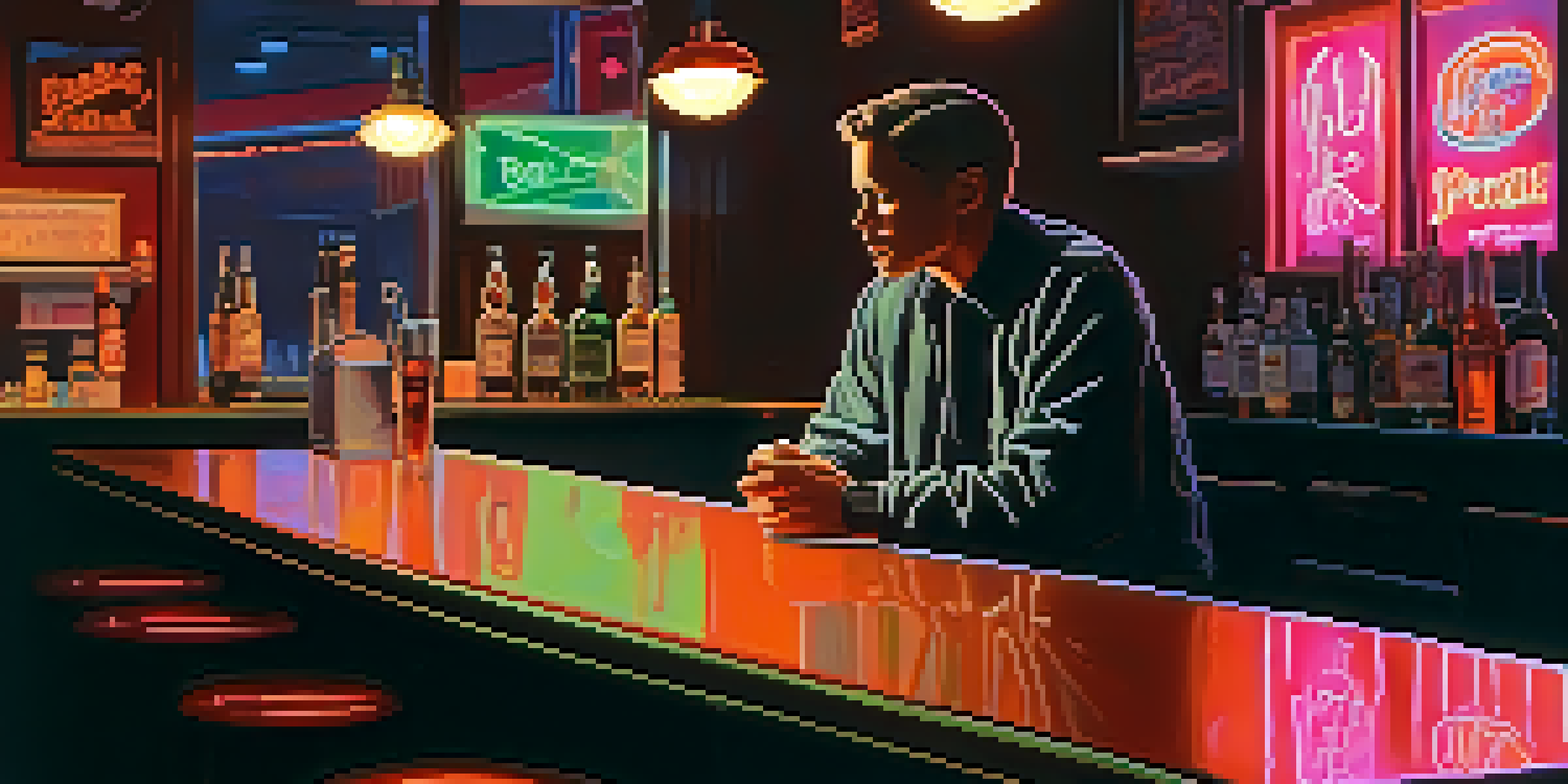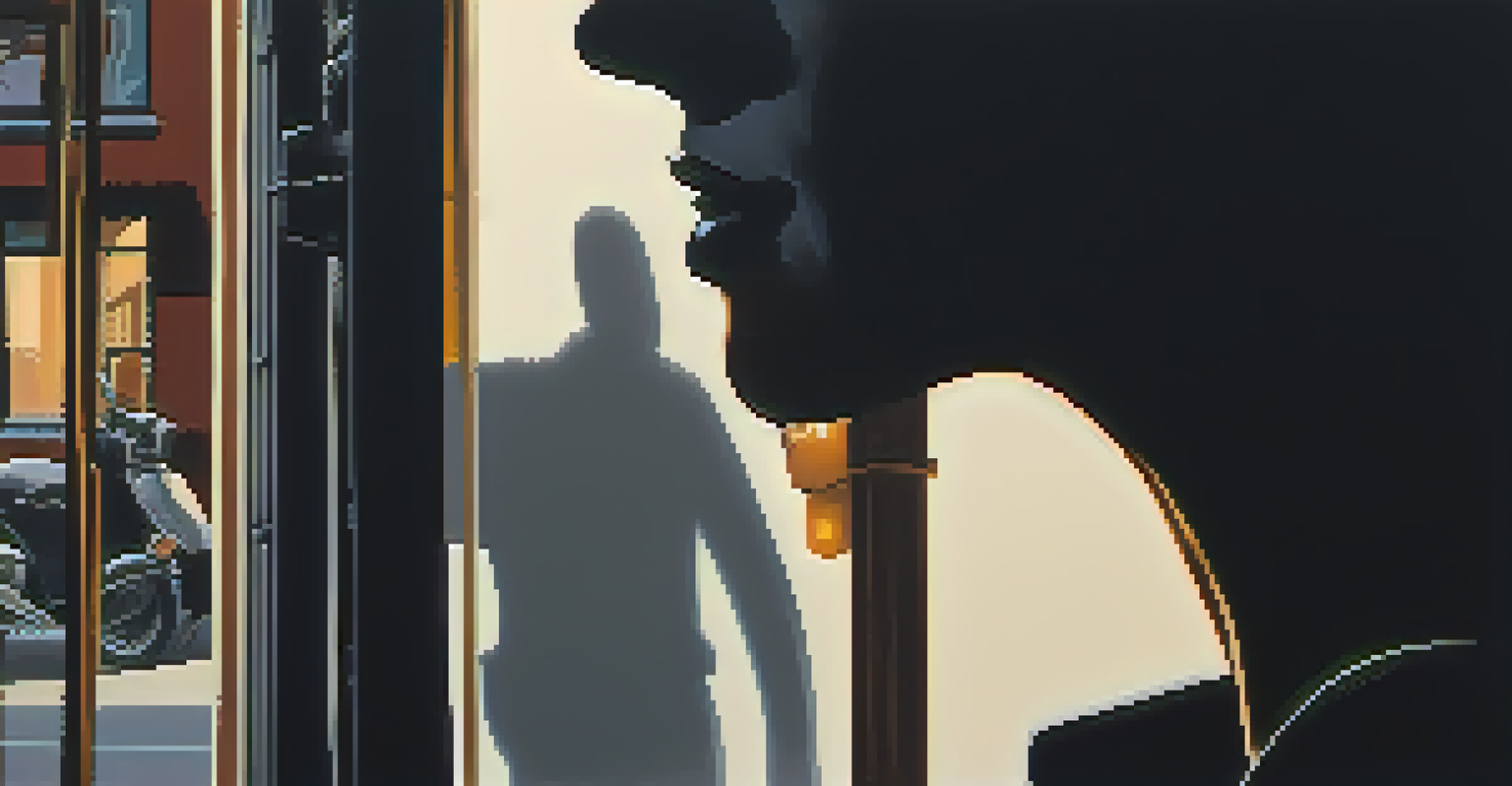Visual Aesthetics of Film Noir: Shadows and Lighting Techniques

Understanding Film Noir: A Brief Overview
Film noir is a cinematic style that emerged in the 1940s, characterized by its dark themes and moral ambiguity. It often features complex characters, especially anti-heroes, who navigate a world filled with deception and danger. This genre not only tells a compelling story but also paints a visual landscape that reflects its gritty and tense narratives.
Film noir is a style that is distinct in its use of light and shadow to create a sense of moral ambiguity and psychological depth.
At the heart of film noir lies a distinct visual aesthetic that relies heavily on shadows and lighting. These elements work together to create an atmosphere of suspense and unease, drawing viewers into the psychological depths of the characters. By manipulating light and shadow, filmmakers can evoke emotions and set the tone of the narrative.
Understanding the visual style of film noir is crucial for appreciating its storytelling techniques. The interplay of light and dark ultimately shapes the viewer's experience, making it an essential aspect of the genre. As we delve deeper into the techniques employed in film noir, we will unveil how shadows and lighting contribute to its lasting impact.
The Role of Shadows in Film Noir
Shadows are a defining feature of film noir, often used to enhance the mood and create tension. They symbolize the hidden aspects of characters' lives, representing secrets, guilt, and inner turmoil. By casting shadows strategically, filmmakers can suggest that something sinister lurks just out of sight.

For instance, consider how shadows are used to depict characters in a state of moral conflict. When a character is shown partially obscured by shadow, it hints at their dual nature—both good and evil. This visual cue engages the audience, inviting them to ponder the complexities of the character's motivations.
Shadows Enhance Film Noir's Mood
Shadows are crucial in film noir as they symbolize hidden aspects of characters' lives and create tension throughout the narrative.
Moreover, shadows can also serve practical purposes within the narrative. They can indicate danger or foreshadow impending doom, heightening suspense. By understanding how shadows function in film noir, we can appreciate their role in shaping the story and its characters.
Lighting Techniques: High Contrast and Chiaroscuro
One of the most notable lighting techniques in film noir is high contrast, which emphasizes the interplay between light and shadow. This technique creates a stark visual experience that can be both striking and unsettling. By using bright lights against deep shadows, filmmakers can draw attention to specific elements, intensifying the emotional impact of a scene.
The shadows in film noir are not just visual elements; they are part of the storytelling, revealing the hidden depths of character and plot.
Chiaroscuro, an Italian term meaning 'light-dark,' is another essential technique in film noir. It involves the use of bold contrasts between light and dark areas to create a three-dimensional effect. This technique not only adds depth to the visuals but also evokes feelings of tension and foreboding, essential elements in film noir storytelling.
The careful application of these lighting techniques results in visually captivating scenes that linger in the viewer's mind. By mastering high contrast and chiaroscuro, filmmakers craft a visual language that speaks volumes, complementing the darker themes present in film noir.
Use of Practical Lighting in Film Noir
Practical lighting refers to the use of visible light sources within a scene, such as lamps or streetlights. In film noir, practical lighting is often employed to create a sense of realism while enhancing the mood. These light sources can cast dramatic shadows that contribute to the overall aesthetic, making the environment feel more immersive.
For example, a dimly lit bar with a neon sign flashing outside can evoke a sense of loneliness and desperation. The interplay of the neon light and shadows can create a visually engaging atmosphere that reflects the inner struggles of the characters. This technique effectively grounds the story in a believable setting while adding a layer of emotional depth.
Lighting Techniques Create Atmosphere
High contrast and chiaroscuro lighting techniques are essential in film noir, shaping the visual experience and evoking emotional responses.
By incorporating practical lighting, filmmakers can control the atmosphere and tone of a scene. This method not only enhances the visual experience but also reinforces the themes of isolation and entrapment that are prevalent in film noir.
Symbolism of Light and Dark in Character Development
In film noir, the use of light and dark often serves a symbolic purpose, reflecting the complexities of character development. Characters who are bathed in light may represent purity or innocence, while those shrouded in darkness often embody moral ambiguity or corruption. This visual cue helps audiences quickly grasp the nature of each character's journey.
For instance, a protagonist who starts out in bright, well-lit scenes may gradually become enveloped in shadow as they make choices that lead them down a darker path. This transformation not only visually represents their moral decline but also engages the audience in their internal struggle. It’s a subtle yet powerful storytelling tool.
By studying the symbolism of light and dark, viewers can gain deeper insights into character arcs and motivations. This visual representation invites audiences to look beyond the surface, encouraging them to consider the psychological depths of the characters they encounter in film noir.
The Impact of Lighting on Setting and Atmosphere
The lighting in film noir plays a pivotal role in establishing the setting and atmosphere. Different lighting techniques can transform an ordinary location into a haunting backdrop that enhances the narrative. Whether it’s a foggy street illuminated by a single streetlamp or the dim interior of a smoky lounge, lighting sets the emotional tone of a scene.
For example, a scene set in a dark alley with harsh shadows can evoke feelings of danger and uncertainty, immersing viewers in the characters’ perilous situations. This atmospheric tension is crucial in keeping audiences engaged and invested in the story as it unfolds. The setting becomes a character in its own right, influenced by the decisions made in lighting design.
Light and Dark Symbolize Character Arcs
The interplay of light and dark in film noir visually represents character development, reflecting their moral journeys and internal struggles.
Ultimately, the impact of lighting on setting and atmosphere cannot be overstated. It serves as a powerful tool that shapes the viewer's emotional response, guiding them through the twists and turns of the narrative while reinforcing the overall aesthetic of film noir.
Conclusion: The Lasting Influence of Film Noir Aesthetics
The visual aesthetics of film noir, particularly through the use of shadows and lighting techniques, have profoundly influenced the art of filmmaking. This genre has not only shaped the way stories are told but has also inspired countless filmmakers across various genres. Its unique style continues to resonate with audiences, making it a timeless classic.
As we have explored, the interplay of light and shadow in film noir reveals much about its characters, themes, and emotional depth. By mastering these techniques, filmmakers create a visual language that enhances storytelling and invites viewers to engage with complex narratives. This legacy of film noir remains relevant today.

In conclusion, the shadows and lighting techniques that define film noir are essential components of its rich visual storytelling. They invite us to explore the darker sides of humanity while delivering captivating cinematic experiences that leave a lasting impression.